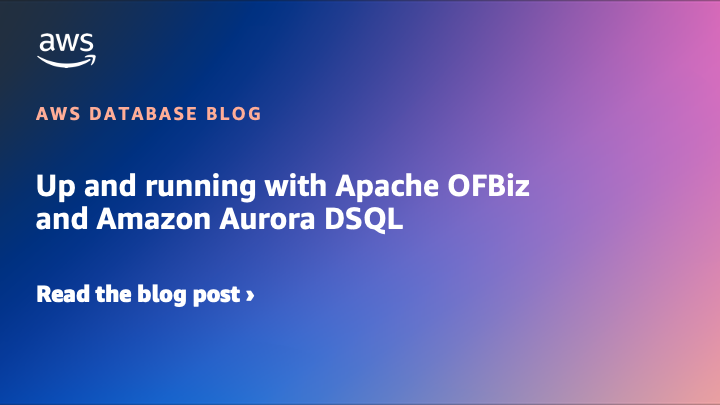AWS Database Blog
Category: Amazon Aurora
Up and running with Apache OFBiz and Amazon Aurora DSQL
In this post, we show you a worked example of taking an existing application that works on PostgreSQL databases and adapting it to work with an Aurora DSQL database. In addition to adapting for the previously mentioned aspects, we also address some data type incompatibilities and work around some limits that currently exist in Aurora DSQL.
Transition a pivot query that includes dynamic columns from SQL Server to PostgreSQL
When assisting customers with migrating their workloads from SQL Server to PostgreSQL, we often encounter a scenario where the PIVOT function is used extensively for generating dynamic reports. In this post, we show you how to use the crosstab function, provided by PostgreSQL’s tablefunc extension, to implement functionality similar to SQL Server’s PIVOT function, offering greater flexibility.
Integrate natural language processing and generative AI with relational databases
In this post, we present an approach to using natural language processing (NLP) to query an Amazon Aurora PostgreSQL-Compatible Edition database. The solution presented in this post assumes that an organization has an Aurora PostgreSQL database. We create a web application framework using Flask for the user to interact with the database. JavaScript and Python code act as the interface between the web framework, Amazon Bedrock, and the database.
Scheduled scaling of Amazon Aurora Serverless with Amazon EventBridge Scheduler
In this post, we demonstrate how you can implement scheduled scaling for Aurora Serverless using Amazon EventBridge Scheduler. By proactively adjusting minimum Aurora Capacity Units (ACUs), you can achieve faster scaling rates during peak periods while maintaining cost efficiency during low-demand times.
Long-term backup options for Amazon RDS and Amazon Aurora
In this post, we show you several long-term data backup strategies and how to effectively implement them in the AWS environment, with a focus on Amazon Relational Database Service (Amazon RDS) and Amazon Aurora.
Migrate very large databases to Amazon Aurora MySQL using MyDumper and MyLoader
In this post, we discuss how to migrate MySQL very large databases (VLDBs) from a self-managed MySQL database to Amazon Aurora MySQL-Compatible Edition using the MyDumper and MyLoader tools.
Upgrade strategies for Amazon Aurora PostgreSQL and Amazon RDS for PostgreSQL 12
In this post, we explore the end-of-life (EOL) timeline for Aurora PostgreSQL and Amazon RDS for PostgreSQL. We discuss features in PostgreSQL major versions, Amazon RDS Extended Support, and various upgrade strategies, including in-place upgrades, Amazon RDS blue/green deployments, and out-of-place upgrades.
How Mindbody improved query latency and optimized costs using Amazon Aurora PostgreSQL Optimized Reads
In this post, we highlight the scaling and performance challenges Mindbody was facing due to an increase in their data growth. We also present the root cause analysis and recommendations for adopting to Aurora Optimized Reads, outlining the steps taken to address these issues. Finally, we discuss the benefits Mindbody realized from implementing these changes, including enhanced query performance, significant cost savings, and improved price predictability.
Multi-tenant vector search with Amazon Aurora PostgreSQL and Amazon Bedrock Knowledge Bases
In this post, we discuss the fully managed approach using Amazon Bedrock Knowledge Bases to simplify the integration of the data source with your generative AI application using Aurora. Amazon Bedrock is a fully managed service that makes foundation models (FMs) from leading AI startups and Amazon available through an API, so you can choose from a wide range of FMs to find the model that is best suited for your use case.
Self-managed multi-tenant vector search with Amazon Aurora PostgreSQL
In this post, we explore the process of building a multi-tenant generative AI application using Aurora PostgreSQL-Compatible for vector storage. In Part 1 (this post), we present a self-managed approach to building the vector search with Aurora. In Part 2, we present a fully managed approach using Amazon Bedrock Knowledge Bases to simplify the integration of the data sources, the Aurora vector store, and your generative AI application.









